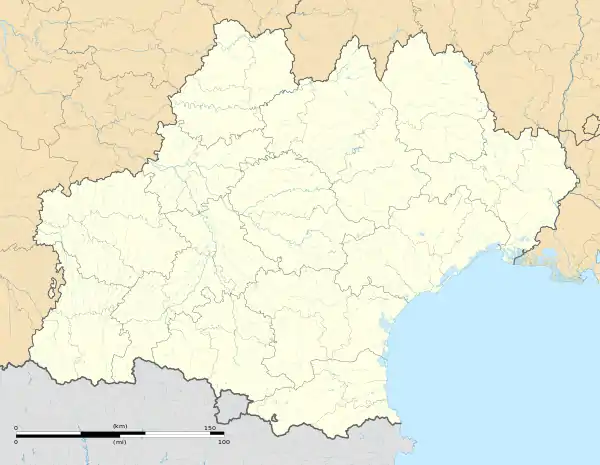Le Vernet | |
|---|---|
 Memorial for the Le Vernet Internment Camp | |
Location of Le Vernet | |
 Le Vernet  Le Vernet | |
| Coordinates: 43°11′10″N 1°36′11″E / 43.1861°N 1.6031°E | |
| Country | France |
| Region | Occitania |
| Department | Ariège |
| Arrondissement | Pamiers |
| Canton | Portes d'Ariège |
| Government | |
| • Mayor (2020–2026) | Xavier Ragaru[1] |
| Area 1 | 5.59 km2 (2.16 sq mi) |
| Population | 704 |
| • Density | 130/km2 (330/sq mi) |
| Time zone | UTC+01:00 (CET) |
| • Summer (DST) | UTC+02:00 (CEST) |
| INSEE/Postal code | 09331 /09700 |
| Elevation | 235–376 m (771–1,234 ft) (avg. 261 m or 856 ft) |
| 1 French Land Register data, which excludes lakes, ponds, glaciers > 1 km2 (0.386 sq mi or 247 acres) and river estuaries. | |
Le Vernet (French pronunciation: [lə vɛʁnɛ]; Languedocien: Lo Vernet) is a commune in the Ariège department in southwestern France.
Population
Inhabitants of Le Vernet are called Vernétois.
| Year | Pop. | ±% |
|---|---|---|
| 1962 | 323 | — |
| 1968 | 382 | +18.3% |
| 1975 | 417 | +9.2% |
| 1982 | 464 | +11.3% |
| 1990 | 508 | +9.5% |
| 1999 | 536 | +5.5% |
| 2008 | 632 | +17.9% |
History
It was the site of Camp Vernet, a concentration camp built in 1918. During World War II it was used by the Vichy authorities to intern "undesirable aliens", primarily European refugees, including Jews, and as a transit camp for detained Jews who were to be deported to Nazi labor and extermination camps.
Transport
Le Vernet-d'Ariège station has rail connections to Toulouse, Foix and Latour-de-Carol.
See also
References
- ↑ "Répertoire national des élus: les maires". data.gouv.fr, Plateforme ouverte des données publiques françaises (in French). 9 August 2021.
- ↑ "Populations légales 2021". The National Institute of Statistics and Economic Studies. 28 December 2023.
Wikimedia Commons has media related to Le Vernet, Ariège.
This article is issued from Wikipedia. The text is licensed under Creative Commons - Attribution - Sharealike. Additional terms may apply for the media files.